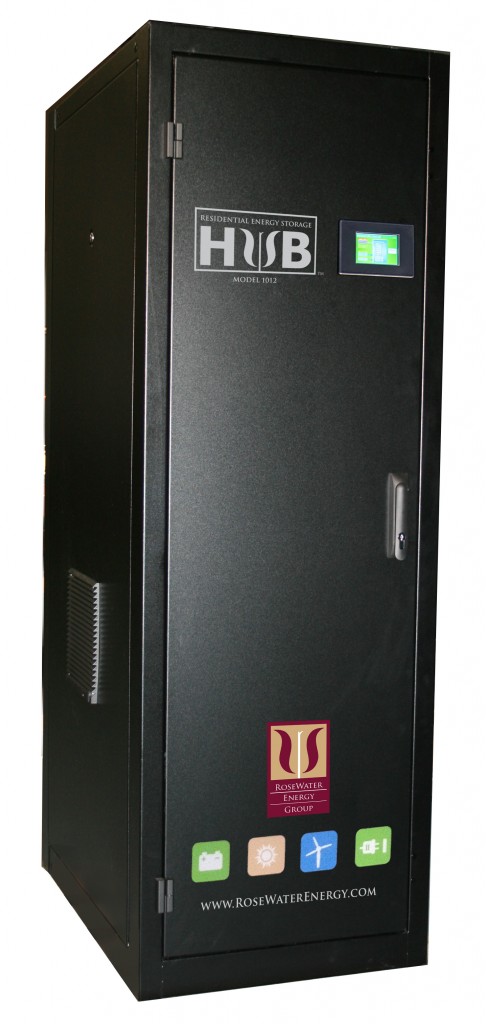We first met the Rosewater Energy Group at the 2012 CEDIA Expo – a coming out party for the new company that makes a residential energy storage hub with batteries to store your energy from either the power company or renewable sources (i.e. solar or wind) and a capacity large enough to power your whole home with processed and purified 115 volt sine-wave power. Founded by well-known industry personality Joe Piccirilli, Rosewater is on the leading edge of a new concept in energy delivery, storage, and usage.
Now, one year later, how has Rosewater’s business developed? See below…
“Well, the first year has been a year of real…learning,” Piccirilli told us in a telephone interview just prior to CEDIA. And, apparently, a year of change based on what was learned as Rosewater has made significant changes including reconfiguring its major product in several dramatic ways.
The Rosewater Energy Storage Hub (RESH) was shown to the public for the first time at the Expo last year, and we had commented on the rather imposing physical dimensions of this original concept – soaring 7- or 8-feet tall on its display stand and a full 5-feet wide with two side-by-side metal cabinets – one for control and power processing, and the other to house the large storage batteries.
Feedback led to complete product redesign…

Piccirilli told us that the company received tremendous feedback from integrators and other partners about various aspects of the product…leading to a significant redesign of the core RESH model. The input they received at CEDIA caused them to look at the RESH “through the eyes of installers and system integrators – looking at, OK, what are the problems going to be in installation. What may hold this product back.”
The net result was the company went back to the drawing board on the basic battery used in the unit, which, last year was a lead/carbon design. “If you use a lithium-ion or the Durathon (a GE battery design based on a sodium/nickel construction) you end up having a much smaller floor space with the same amount of storage.”
By changing the basic battery that the hub is based upon, the new version of the RESH has a much smaller footprint: only a 24-inch width versus a 60-inch width in the original design. “A significant reduction,” Piccirilli emphasized.
New component construction…
Perhaps equally impactful – the new hub design separates the electronics/control portion from the battery portion. With this new kind of component design, the homeowner can expand or contract the amount of storage for their individual needs – as well as place the control unit in a more accessible position while the batteries can be in a more convenient out-of-the-way location (such as a basement, garage, or outdoors).
These upgrades to the design carry no premium beyond the original $45,000 premium (retail) pricing. So a more convenient size, more flexible positioning and operation…but all offered at the same price.
See a video on Rosewater’s Energy Storage Hub…
Queens University study details system payback…
Rosewater also participated in a detailed research study conducted by the Engineering School at Queens University in Kingston, Ontario to determine the value of highly distributed energy storage to utilities. The school collected data from PJM (Pennsylvania, New Jersey, Maryland power authority), and PowerStream (an Ontario-based energy distribution company) for input into the study.
“What’s happening in utilities right now is the difference between the power necessary to meet peak demand versus off-peak demand is a ratio of two-to-one or greater…and growing,” Piccirilli said. “So the amount of power needed to be generated to meet peaks is much, much greater than the off-peak which is at night.”
It’s all about load leveling…
It is difficult and inefficient for the utility to generate power for peak demand, Piccirilli told us. But distributed energy storage can “load-level” – or what Piccirilli called “peak-shave” by using non-peak power to charge the local hub’s batteries which then provide the power needed during peak usage times.
According to Piccirilli, the Queens University study concluded that load shifting is the main benefit of a network of residential energy storage hubs. And thanks to what Piccirilli says was very positive and compelling numbers from the study, the company is in discussion with several utility companies who are considering deploying a network of widely distributed energy storage systems.
Utility to conduct in-field testing…
PowerStream has signed on with Rosewater to conduct a study of this type of system and has purchased 10 of Rosewater’s hubs to install in residences for testing. This is the first such in-field trial of the Rosewater system and if satisfactory for the utility, could mark the development of an entirely new market.
Piccirilli envisions a program with utilities where they will provide the hubs to their customers at no up-front charge in order to create a wide-area network of energy storage hubs. Then the customer will be billed a small monthly fee much like a cable box rental charge. This allows the utility to defer building new plants to handle ever-increasing community peak power demands and provides greater stability for the consumer with no power outages that can happen when peak demand exceeds delivery capability.
Getting consumers and utilities on the same page…
Why sell the utilities and not the consumers direct? Piccirilli tells us that the company will approach both markets. But with support from utilities, they become marketing partners who help build demand for – and potentially finance – the Rosewater system.
“It’s been a busy year,” Piccirilli laughed. Although most of the progress from Rosewater’s activities have been going on behind the scenes.
For all the latest on Rosewater Energy Products, see: www.rosewaterenergy.com.






Leave a Reply